The Safari Rally Kenya, distinct in the WRC calendar, necessitates significant modifications to cars for improved durability against the demanding terrain and unpredictable weather. Key enhancements include snorkels, taller suspensions, and engine adjustments for high altitude. The event will draw 39 drivers globally, showcasing brands like Toyota, Hyundai, and Ford, and attract millions of viewers, with an in-person audience of around 100,000.
The Safari Rally Kenya, taking place this weekend in Naivasha, is distinct on the World Rally Championship (WRC) calendar due to considerable visual and mechanical modifications made to the cars. According to WRC, these adaptations are not merely aesthetic but essential to endure the challenging conditions of Kenya’s racing routes, recognized as one of the most demanding rallies globally.
The rugged terrain and variable weather in Kenya pose a unique challenge for both drivers and vehicles. The event officially commences today, March 20, with a flag-off by President William Ruto, followed by the Super Special Stage in Kasarani, after which the cars will proceed to the Naivasha region in Nakuru County. Crew members will navigate 384 competitive kilometers, marking the longest rally distance this year, traversing harsh roads, deep water crossings, and high-velocity segments.
Several key enhancements distinguish the Safari Rally cars: The first prominent addition is the snorkel, an elevated air intake installed on the vehicles. This critical component facilitates engine performance during deep water crossings, thus preventing water ingestion and potential stalling, a notable risk with the unpredictable weather conditions.
Moreover, the suspension system of the cars has been elevated to meet the demands of the Safari Rally, which requires a higher ride height than other events. The modifications enable the vehicles to navigate relentless terrain features such as sharp ruts and large rocks that could disrupt the rally. The crucial balance between ground clearance and stability is vital, as the event challenges not only the endurance of the cars but also their speed on rapid sections.
Additionally, teams have fine-tuned their engines to adapt to the high-altitude environment of Naivasha, where thinner air reduces engine power. Each boost in performance is critical as drivers propel their cars across the stunning African landscape. This year’s rally has lured 39 drivers from diverse nations and is anticipated to attract over 85 million viewers globally, with around 100,000 spectators expected to attend in person in Naivasha.
Participants will include prominent car brands such as Toyota, Hyundai, and Ford. According to WRC, Hyundai Motorsport aims to end Toyota’s unbroken streak in the Safari since its return to WRC in 2021. The team, led by Thierry Neuville, Ott Tänak, and Adrien Fourmaux, is deploying the i20 N Rally1 cars. Additionally, M-Sport Ford will showcase three Puma Rally1 cars driven by Grégoire Munster, Josh McErlean, and Jourdan Serderidis. In the WRC2 category, reigning champion Oliver Solberg leads in a Toyota GR Yaris Rally2, alongside debutant Kajetan Kajetanowicz with a similar vehicle.
The Safari Rally Kenya presents unique challenges requiring significant modifications to the rally cars, transforming their design and capabilities to tackle the harsh conditions effectively. Key enhancements include snorkels for water crossings, heightened suspensions for rugged terrain, and engine tuning for high-altitude performance. With a rich participation from global drivers and brands, the event promises to be a focal point for motorsport enthusiasts worldwide.
Original Source: www.the-star.co.ke




